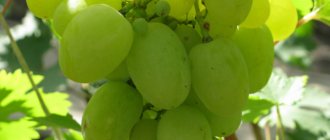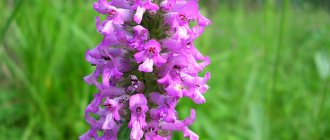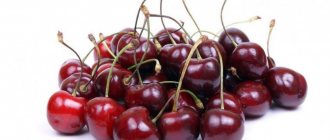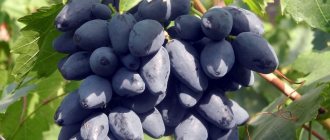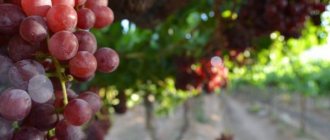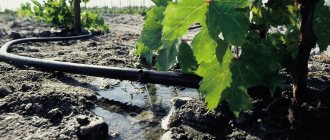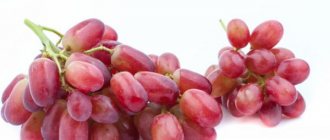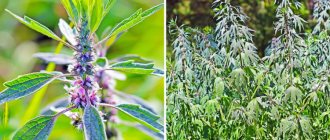Nature, generous with surprises, constantly pleases us with miracle plants that are good for health. Man improves them, develops new varieties suitable for storage, transportation, and acclimatization in new conditions. Today you won’t surprise Russians with papaya or feijoa. Kiwano or horned melon is new to our market, but it has already impressed exotic lovers with its unusual appearance and taste. The question in what form it is eaten and how best to prepare it will certainly interest gourmets. And summer residents can easily grow this useful fruit in all respects in the garden or balcony - breeders have done their best in this regard, and there are already varieties suitable for growing in such conditions.
What kind of fruit is Kiwano?
Externally, kiwano looks like a large overripe cucumber. The yellow peel is full of pointed pimples. The size of the fruit is from 10 to 15 centimeters, weight 250-300 grams, oblong in shape, like a melon.
Taste of Kiwano
Under the thick, inedible peel there are many cucumber-like seeds. The pulp is juicy and jelly-like. Kiwano tastes like cucumber and banana, some varieties have a citrus flavor.
Taste of Kiwano
Where does kiwano grow?
The homeland of kiwano is Africa, the plant is widespread and is considered a fruit. In Israel, Central America and New Zealand it is a vegetable crop. It does not tolerate low temperatures, so cultivation in our climate is possible only in specially equipped greenhouses or in summer beds.
Where does kiwano grow?
How to grow kiwano
The process of harvesting, growing and transporting is similar to cucumbers. Kiwano grows in the beds. For climbing plants, pegs are made on which the vine is woven. The fruit is grown on large plantations from May to October. As the fruits ripen, they are collected, labeled, packaged and sent for delivery.
Both!
In botany, a vegetable is any edible part of a herbaceous plant. Kiwano is a creeping vine. Its fruits are used as food, and some African tribes use its leaves. From this point of view, kiwano can be classified as a vegetable.
However, any fruit consisting of pulp and seeds is considered a fruit. You may be surprised, but kiwanos, cucumbers and tomatoes can safely be called fruits. Moreover, many botanists also classify zucchini as a fruit! Therefore, no matter what you think Kiwano is, you will be absolutely right.
Composition and calorie content of kiwano
Kiwano fruit contains practically no sugar, which makes it a dietary product. Composition of fruit per 100 grams:
- 45 kcal;
- 2 g proteins;
- 1 g fat;
- 7 g carbohydrates.
The juicy jelly-like pulp of the kiwano fruit consists of 90% water and contains 5% dietary fiber - cellulose. They eat kiwano on a low-carbohydrate diet; the minimum number of calories in its composition makes the fruit a recommended product for obesity and diabetes.
On a note!
The glycemic index of kiwano is 37 units.
Composition and calorie content of kiwano
Sowing care
When growing kiwano, it is important to maintain the temperature within +25 degrees after sowing the seeds. Only minimal fluctuations are allowed, within two degrees! Maximum daylight is needed, but when seedlings emerge, the plant is shaded to avoid burns.
To speed up growth, you need to constantly keep the soil moist. The water should not stagnate for a long time, so you will have to frequently loosen the soil both before and after the emergence of seedlings.
Planting of horned melon in a permanent place occurs 4-5 weeks after sowing, and this depends on the development and condition of the seedlings. The plant must be completely healthy and strong, and night temperatures in the open air should not be lower than 10–12 degrees Celsius. At first, you will still have to place the plant under the film, so it will have a better chance of taking root.
The nutritional value
In its homeland, the fruit is considered the fruit of longevity. Kiwano contains all the vitamins and microelements necessary for the body.
Vitamins
- A, beta-carotene - 90 mcg;
- B2, thiamine - 0.03 mg;
- B2, riboflavin - 0.015 mg;
- B3 or vitamin PP, niacin - 0.7 mg;
- B5, pantothenic acid - 0.2 mg;
- B6, pyridoxine - 0.1 mg;
- B9, folic acid - 3 mcg;
- C, ascorbic acid—5.5 mg.
Macronutrients
- potassium - 125 mg;
- calcium - 15 mg;
- sodium - 2 mg;
- magnesium - 42 mg;
- phosphorus - 38 mg.
Microelements
- iron - 1.2 mg;
- manganese - 38 mcg;
- copper - 22 mcg;
- zinc - 0.48 mg.
Kiwano is rich in beta-carotene. The substance is synthesized in plants during photosynthesis and is not produced by the body. Doctors recommend eating juicy fruits to prevent eye diseases. In winter, kiwano is eaten to support the immune system; the fruit contains an optimal combination of potassium, iron and vitamin C.
The nutritional value
Choosing a place
Growing kiwano from seeds is not as difficult as it seems, but you still need to follow generally accepted rules that allow you to achieve a good harvest:
- The plant is light-loving, but is afraid of direct sunlight. Under the crowns of bushes and trees, kiwano will develop slowly; more effort will be spent on the development of greenery, since it does very well in the shade! But we need a harvest, and not abundant green mass, so the priority is open, windless areas, shaded by a fence (it can even be a simple chain-link fence).
- To have more harvest and make it easier for you to collect it, place supports like for cucumbers.
- Kiwano does not tolerate crowding, it develops quickly and spreads, plant it only in a large area, without the proximity of other plants.
Plants must be planted at least 40 cm apart from each other. Usually, kiwanos are planted so that there are no more than two bushes per square meter.
Health benefits of kiwano
The juicy fruit is recommended for children and adults to eat. The beneficial properties of kiwano have long been used in folk medicine in countries where the fruit is popular and grows all year round.
General
- Kiwano fruit contains a lot of water with potassium ions. The microelement is necessary to maintain the functioning of the cardiovascular system.
- During the hot season, the fruit perfectly quenches thirst and restores water balance.
- Kiwano juice contains copper, an essential element for hematopoiesis. Fresh juices are part of the diet after surgery.
- The fruit regulates the balance of glucose in the blood and is suitable for the diet of people with diabetes; it has a low glycemic index.
- The pulp restores the salt balance, has an optimal combination of mineral salts, and saturates the cells with water and oxygen.
For men
- Kiwano thins the blood, improves circulation and helps increase potency.
- The fruits contain a balanced composition of vitamins and microelements and are recommended for preparing protein shakes before and after training in the gym.
For women
- Kiwano pulp contains antioxidants; the fruit is widely used in cosmetology in the manufacture of products for the care of problem skin.
- The fruits must be eaten to restore the level of red blood cells after menstruation.
- The fruit is useful for weight loss; it contains dietary fiber that cleanses the intestines of accumulated toxins.
For children
- It is useful for children to eat kiwano to increase immunity during the cold season. The fruit is useful for improving blood condition in case of anemia; the juice is rich in copper, which promotes the production of red blood cells.
On a note!
For minor abrasions and cuts, fresh juice stops bleeding and has an antiseptic effect on the wound.
Health benefits of kiwano
Kiwano
I brought Kiwano seeds from the meeting and dug through a bunch of information to figure out this exotic plant. I made a reminder for myself, I’m leaving it out, maybe someone else will need it.
Kiwano is a funny name. No, this is not a “Georgian relative” of kiwi... Because of its bizarre shape, kiwano is called a horned melon or cucumber. The fruits are usually bright orange or red in color and grow up to 15 cm in length.
Useful properties of kiwano
89% of the Kiwano fruit is water. This is a very low-calorie product, ideal for those who are watching their figure.
In the countries where it grows, kiwano pulp is used as a means to quickly heal wounds. It is believed that it helps cleanse the body of toxins, strengthens the immune system and has a general tonic effect on the body.
One of the main advantages of this fruit is its high content of vitamin A, C, and B vitamins, which are so necessary for the normal functioning of the body. Also from vitamins: niacin (B3), riboflavin (B2), folic acid (B9), thiamine (B1). Mineral content: potassium, magnesium, phosphorus, calcium, iron, copper and zinc.
Kiwano is useful for those who suffer from gastrointestinal and cardiovascular diseases, due to its high potassium content.
Also, this fruit is very useful for children due to the presence of vitamin PP and ascorbic acid.
Vitamins A, zinc and copper have a beneficial effect on the condition of our skin, increase elasticity and improve cell regeneration function.
Kiwano is simply an ideal fruit for weight loss. Its light and delicious
The peel is inedible, but the flesh tastes like a mixture of fresh cucumber and lemon; to many it resembles lime and banana. Can be used both in salads and desserts. Kiwano fruits contain a lot of vitamin C and PP vitamins. The fruit is low in calories.
It is often used as a decorative element.
Picked kiwano fruits, unlike ordinary cucumbers, can be stored for six months at room temperature, ripening and turning yellow. When the rare vegetable first appeared in Russian supermarkets, it came with a recipe that said: “A mixture of kiwano fruit pulp with yogurt is the best start to the day for an elderly person.
Kiwano is a native of the subtropical and tropical countries of South Africa, South America and the Antilles. Its various types and forms are widely cultivated in countries with hot climates, but they specialize in its cultivation in New Zealand, Israel, the USA (California), and Colombia. Kiwano combines many qualities of both an ornamental and vegetable crop. During the growing season, this liana forms numerous thin but strong faceted stems 3-6 m long. Branching out, they tightly weave a huge area over the summer. The leaves of the kiwano are five-lobed with hard pubescence, similar to smaller copies of cucumber leaves (anguria leaves are similar to watermelon), creating a continuous green curtain on the support nets. Small yellow numerous flowers, just like those of the cucumber, are female and male, located along the entire length of the shoot in the axils of the leaves. They open in the morning and bloom until noon. Quite a lot of ovaries are formed. When grown in a greenhouse and properly cared for, up to 200 fruits can be harvested from one plant per season. Results close to this can be obtained if you collect greens constantly, but if you leave the fruits until they are fully ripe, their quantity will be much smaller.
Kiwano agricultural technology is very simple: regular watering, fertilizing with organic and complex fertilizers, tying stems to supports. In order to produce more fruit, grown green plants must be removed in a timely manner and the vine must be pinched, limiting the growth of shoots with a male type of flower. It is advisable after each harvest to water the plants abundantly and carry out root or foliar fertilizing with an infusion of herbs with the addition of a small amount of fermented mullein, alternating them with fertilizing with a complete mineral fertilizer in combination with microelements.
This vine is demanding of heat and light, but in the open sun the leaves can suffer from burns, and the buds and ovaries may crumble. The soil, like all pumpkin crops, prefers light, moisture- and breathable soil, rich in organic matter. Kiwano does not tolerate either prolonged drought or stagnation of water at the roots. The root system of the plant is poorly developed and is located superficially, so it is advisable to mulch the soil rather than loosen it. The indisputable advantage of kiwano is its abundant fruiting and resistance to various diseases and pests characteristic of pumpkin crops.
The taste of kiwano fruits is unusual and delicate, reminiscent of cucumber, melon, and banana at the same time, and some even catch the taste of kiwi, lime and avocado. Therefore, Kiwano greens can be used in both sweet and savory dishes, eaten fresh, like cucumbers in salads, as well as salted and pickled. Kiwano goes well with various berries and fruits in jams and compotes. Fruit slices and seeds in jelly capsules can be used to decorate desserts, fruit salads, ice cream, and drinks.
Kiwano halves, if the pulp is removed and placed on large spikes, will become a “fashionable” utensil for various sweet dishes, meat, fish and vegetable cold appetizers and a fun accessory for festive table setting. In areas where Kiwano grows, a popular dish is soft cheese mixed with seafood and topped with emerald jelly with seeds. This dish is served in bowls made from Kiwano peel. Kiwano fruits are stored for quite a long time, so we can decorate the table with such a dish in winter and spring in order to surprise guests with its unique tropical beauty.
Pickled gherkins from the fruits of a 3-4-day ovary are considered a real delicacy among gourmets and are superior in taste to cucumber ones. In addition, compared to cucumbers, kiwano has a richer composition of substances beneficial to our body (ascorbic acid, P-active substances, alkaline mineral salts, organic acids and sugars). Kiwano fruits are indicated for the prevention of cardiovascular and gastrointestinal diseases; they are actively used in cosmetology (masks made from kiwano juice, honey and yogurt are especially popular). In places where kiwano grows, the astringent properties of its juice are used to heal wounds and burns. And yogurt with Kiwano juice is simply a healing nectar, since the juice has a very high potassium content. A remarkable property of kiwano is that its fruits, when ripe, are covered with a wax-like film, which allows already ripe fruits to be stored even at room temperature for about six months.
After listing the many advantages of Kiwano, the question immediately arises: why is this culture, if it is so wonderful, still not widespread among us? This is precisely the secret of the exotic “cucumber”. Although kiwano is a relative of the usual cucumber, it belongs to plants of short daylight hours; in our conditions it grows for a long time and blooms very late
The temperature for seed germination should be at least 18 °C, for seedlings - 25 °C. Therefore, there is no need to rush to plant kiwano in a permanent place in the greenhouse, and even more so in open ground before the plant undergoes hardening and night temperature is established.
Harm and contraindications
Kiwano fruits do not contain sugar, are recommended in the diet and are not harmful to people with diabetes. When using for the first time, you should try a small piece and wait 1-2 hours. If there is no allergic reaction to the new product, you can eat the whole kiwano.
Contraindications for use:
- the watery pulp contains many seeds; it is not recommended to eat kiwano for children under 3 years of age;
- For constipation, indigestion and dysbiosis, kiwano should be consumed moderately.
Advice!
The pulp consists of 90% water, which contains pesticides. When growing, do not use chemicals so that kiwano does not harm your health.
Harm and contraindications
Features of cultivation
To date, several cultivated varieties of kiwano have been bred for cultivation in temperate climates. One of the most popular is the “green dragon”.
Like any tropical plant, kiwano will give a decent harvest when grown as 20-25-day-old seedlings. In regions of risky farming, it is better to plant the heat-loving vine in a greenhouse; in the southern regions it can be planted in open ground at the same time as zucchini and pumpkins.
Kiwano agricultural technology is the same as for cucumbers. This plant loves sun, moisture, organic matter and does not tolerate acidic soils. The period from germination to fruiting averages 75-83 days. Cultivated varieties of horned melon grow up to 5 m in length, so when growing on a trellis, the central shoot must be pinched. Like cucumbers, most kiwano ovaries are formed on the side shoots.
Those who do not need to hide the African cucumber in the greenhouse willingly use kiwano for vertical gardening.
If you wish, you can grow exotic vines on glazed balconies and loggias. For one plant you will need a 25 liter box, and even in such conditions you can harvest young fruits, pickle them or pickle them.
Tell anyone who might be interested about kiwano: what it is and what it is eaten with. Fans of exotic fruits will certainly enjoy its extraordinary taste and spectacular appearance.
How to choose when purchasing
In our supermarkets, kiwano is sold individually. To choose a delicious ripe fruit and enjoy the taste of an expensive tropical fruit, follow the selection recommendations.
How to choose the right delicious Kiwano fruit:
- the fruit should be elastic, without dents or black spots;
- bright yellow color, with a marble pattern;
- “horns” are soft and convex;
- ripe fruit is 10-15 centimeters long.
Take the fruit you like and weigh it. Ripe kiwano is very juicy inside, weighing 200-250 grams. If the weight is lower, the fruits were picked unripe, they are watery and have practically no taste.
On a note!
The price of kiwano in Ukrainian supermarkets is 120-150 hryvnia per piece.
Harvesting and storage
Kiwano is harvested in August, when the fruits turn yellow. Such fruits store well, but the taste leaves much to be desired. If you want to get a tasty harvest, start harvesting when the kiwanos are a bright orange hue. After harvesting, the plant produces more fruit. With a proper harvest, one kiwano growing in a greenhouse can produce up to 200 fruits per season. In order to have a good harvest, it is necessary to remove the grown green plants in time and immediately pinch the vine to limit the growth of shoots with male flowers.
The harvest can be stored for up to 6 months, and it does not need to be frozen or placed in the refrigerator. If you want to stock up on fruits for the winter, you can preserve them with salt or sugar. Such preparations will benefit the body in cold weather, saturate it with useful substances and decorate the table for the holidays.
How to store kiwano
The fruit has a dense peel and is well preserved at room temperature. To store each fruit, wrap it in paper and place it in a basket. Store in a dark place at room temperature for up to 3 months.
Unripe fruits ripen just like cucumbers. Place the fruit on a lighted windowsill. After 2-3 days, the peel will turn yellow and you can eat the kiwano.
How to store kiwano
Kiwano's choice
When choosing a horned melon for the first time in the supermarket, you need to consider not only what kiwano is and how to eat it, but also how to correctly determine the ripeness of the fruit.
What you need to pay attention to when choosing an exotic fruit:
- Kiwano peel should be orange;
- You should not buy fruits with green or red peels - in the first case they are unripe, in the second they may already begin to deteriorate;
- there should be no dents, scratches or other damage on the peel;
- the color of the fruit should be uniform, without dark or bright spots;
- a sign of Kiwano maturity is the rich yellow color of the thorns;
- Kiwano should be dense and elastic.
If you plan to store or transport kiwano for a long time, it is best to buy fruits with greenish skin. In 5-8 days they will be fully ripe and ready for consumption.
The storage conditions for kiwano are no different from the storage of cucumbers. Tropical fruit is best kept on the bottom shelf of the refrigerator. Unripe fruits have a dense skin, which ensures a long shelf life - up to 5-6 months.
Growing at home
Growing kiwano is easy. “Horned melon” is unpretentious in care; the main condition is lighted beds and timely, regular watering. You can use kiwano seeds from ripe store-bought fruit or buy them at the store.
Soak the seeds for 1 day in water.
- Prepare the soil; we recommend buying a ready-made mixture marked “For seedlings.”
- Pour the substrate into plastic or paper cups, make a hole and plant one seed at a time.
- Water and cover with film until sprouts appear. It is better to water the kiwano in the evening.
- If you want to grow kiwano in open ground, plant the seedlings when the soil temperature reaches 20°C.
- Near each plant, make a peg along which the vine will curl.
- Water the seedlings regularly, morning and evening. On hot days - as the soil dries out.
- Before the ovary appears, treat each kiwano plant with a pest control product. Any drug against aphids and other insects that damage cucumbers is recommended.
- When the kiwano fruits begin to ripen, strengthen the support - 6-7 large fruits grow on one bush.
- Harvest when ripe.
Growing kiwanos at home is no different from cucumbers.
On a note!
Kiwano seeds are sold in gardening stores at a price of 10 hryvnia for 5 pieces.
Care and transplantation into open ground
During cultivation, it is necessary to follow some rules for caring for the plant:
- maintain the temperature at 25 degrees;
- provide the plant with long daylight hours using fluorescent lamps;
- protect the kiwano from direct rays of the sun to avoid burns;
- keep the soil moist and loosen regularly.
After 4 weeks, you can transplant the kiwano into open ground. To protect a young plant from the cold, you can create a greenhouse for it. The plant needs a lot of space because it grows and spreads quickly. It is preferable to plant it along fences or walls on a flat surface, in a windless, warm place. No more than 2 bushes should be planted per 1 m2. The hole for planting should be 40 x 35 cm in size. The root system of the kiwano is poorly developed and located superficially, does not withstand drought and stagnant water. A big advantage is the plant’s good resistance to pests and diseases.
Water the plant 2-3 times a week if the weather is not very hot. If it is very hot, you need to water every day. It is advisable to do this before sunrise or after sunset. There should be no weeds in the area where kiwano grows; weed the soil regularly. When the earth is covered with a crust, loosen it early in the morning or in the evening.
If the soil gets very hot or cold during the day, hill up. This will protect the roots from hypothermia and overheating and help retain moisture in the ground. For a good harvest, be sure to pinch, removing side shoots. The bushes are formed in the shape of a circle or allowed to stretch out in one continuous line.
Be sure to fertilize the soil, apply mineral and organic fertilizers so that the kiwano grows faster and gains the required amount of green mass. Organic infusions made from chicken manure, mullein or herbs are suitable. It is better to use complex fertilizers from mineral fertilizers. Feeding should be done every 10 days, alternating mineral and organic fertilizers so that the plant does not starve.
If the kiwano has a support, tie the main stem vertically so that the main mass grows upward, this will help save space around it. You can use cucumber mesh. When growing in a greenhouse, you cannot do without a garter, otherwise the plant will spread very much. Kiwano makes a very beautiful hedge, decorated with bright fruits.
Use in cooking
In Africa, kiwano is eaten raw, added to salads and made into desserts. A cocktail made from pulp with banana and ice is popular - it is sold everywhere in the hot weather. The drink instantly refreshes and gives strength, and perfectly satisfies hunger.
The easiest way to eat fresh kiwano is to wash the fruit, cut it in half and eat the juicy pulp and seeds with a spoon. After eating plenty of fresh fruit, prepare interesting dishes.
- Kiwano is a delicious topping for milkshakes and ice cream. The pulp goes well with yogurt, sour cream and milk.
- Jelly, jam and pastille are prepared from the fruit by adding sugar, gelatin or agar-agar.
- The taste of kiwano will complement fresh citrus fruits and add sweetness to the drink without sugar.
- The dense flesh harmonizes perfectly in salads with seafood and chicken. Add some hot spices to create a sweet-spicy flavor.
- Peeled and cut into round slices, kiwano is used as an edible decoration for salads, cocktails and sandwiches.
- Salted pulp is an excellent snack for strong alcoholic drinks.
- Seeds with cores, beaten in a blender with sugar, make a delicious sauce for ice cream.
- Pulp whipped with garlic and hot pepper is an excellent sauce for steaks.
- Kiwano is eaten with fish. To serve, trout or salmon fillets are baked in a pulp sauce.
Advice!
Kiwano can be eaten just like cucumber. Use the unsweetened pulp in vegetable salads.
How to eat Kiwano
For the first time seeing such an unusual exotic, one should ask the question, how to eat Kiwano? The answer is quite simple: usually the African cucumber is eaten without prior preparation; the peel is not suitable for food. Typically, the fruit pulp is eaten along with the seeds, after cutting the exotic fruit into two halves and scooping out the jelly-like pulp.
Many other uses have also been found for it. Its pulp is squeezed to obtain juice. This juice can be consumed in its pure form, but it combines well with other juices, forming a pleasant-tasting mix. Horned melon is also suitable for jelly and jam. It is added as an ingredient to many dishes: fruit salads and snacks. There are quite a few ways to eat it. Kiwano pulp can be used to decorate ready-made dishes.
In general, the taste of Kiwano is not very pronounced; all people note the same thing - sweet with a slight sourness. This allows you to add exotic fruit to compotes; there are known recipes for spicy dishes with the addition of African cucumber, which cannot but please gourmets. It is possible to pickle and salt the fruits. Pickled 4-day-old fruits are a very refined and delicious dish.
Recipes with Kiwano
We offer you to prepare simple and delicious dishes with the African Kiwano cucumber.
Yogurt dessert with kiwano
Ingredients:
- 3 ripe kiwanos;
- 500 ml natural unsweetened yoghurt;
- 5 tablespoons of sugar;
- 25 g gelatin.
Preparation:
Dissolve gelatin in a small amount of water. Beat yogurt with sugar, add gelatin and mix thoroughly.
Cut the kiwano in half and scoop out the pulp with a spoon. Cut into small pieces and mix with yogurt.
Pour yogurt into the peeled halves and leave in the refrigerator for 3-4 hours until set. Before serving, garnish with mint leaves.
Yogurt dessert with kiwano
Cocktail with kiwano and mint liqueur
Ingredients:
- 1 ripe kiwano;
- 50 ml mint liqueur.
Preparation:
Cut the kiwano, remove the pulp and strain thoroughly through a sieve, separating the seeds. Pour juice and liqueur into a shaker and mix. Add ice, pour into glass and serve chilled.
Cocktail with kiwano and mint liqueur
Interesting fruit
Kiwano fruit is called conventionally. In fact, it is a vegetable from the Pumpkin family. Simply put, a close relative of the common cucumber. It is called by different names - African prickly cucumber, two-horned or jelly melon. Those who call it Antillean cucumber or angouria are wrong. These are completely different plants, in which only some external similarities can be noticed.
Double-horned melon is grown everywhere in countries with a hot tropical climate, and is specially bred in New Zealand, the USA (California), Israel and Colombia.
Kiwano is an annual herbaceous vine with thin but strong stems. It reaches 5-6 meters in length. This is a heat-loving, short-day plant that can be grown as a garden crop and as an ornamental vine.
Kiwano leaves are similar to cucumber leaves, only smaller. In their axils there are numerous yellow flowers. Like other pumpkin plants, they are divided into male and female. Throughout the growing season, the vine bears fruit abundantly. By following all the rules of care, you can collect up to 200 fruits from a bush. It is possible to achieve such a result by constantly picking off greens. But the yield can sharply decrease if at least one kiwano fruit remains on the vine and ripens.
Application in medicine
The fruit has a low glycemic index. Nutritionists recommend eating kiwano every day for breakfast. If your doctor has prescribed a therapeutic low-calorie diet, grow fruits at home according to our recommendations.
Kiwano is recommended for dehydration and diarrhea. The fruit is rich in mineral salts and is 90% water. Quickly regulates the balance of microelements, fiber has an astringent effect and stops diarrhea.
Kiwano fruits have long been used in the treatment of wounds. The pulp contains substances that have a hemostatic effect. For cuts, abrasions and other skin injuries, apply a fresh slice to stop the bleeding.
The fruit is rich in vitamin C and antioxidants. Kiwano pulp extract is used by many cosmetic concerns in the production of cosmetics for the treatment of acne and blackheads.
The fruits are rich in antioxidants and microelements necessary for skin aged 45+. Kiwano oils and extract are part of the premium anti-age cosmetics series.
What are the benefits of Kiwano?
The pulp of the fruit contains carbohydrates, vitamins A, B1, B2, B3, B5, B6, B9, C, as well as phosphorus, magnesium, potassium, calcium, manganese, iron, copper.
Kiwano, when consumed regularly, helps improve immunity; it is useful for heart patients and those who are obese. The calorie content of kiwano is only 44 calories, so if possible, the fruit can be included in a diet for weight loss or a therapeutic diet.
Diabetics are allowed to eat the fruit; it has also been noted that if you drink juice with kiwano pulp during a course of chemotherapy, its side effects regarding the condition of the hair will be less pronounced.
Kiwano contains a lot of water, thanks to which it maintains water balance, and potassium, which is contained in large quantities in the fruit, has a beneficial effect on the functioning of the heart muscle.
In general, kiwano is well tolerated by the gastrointestinal tract, and, thanks to its fiber, stimulates peristalsis and helps remove toxins from the body.
You can also use kiwano pulp externally to prepare homemade masks for the skin on the body and face. As a healthy addition, honey, sour milk, egg yolk and other nutritious ingredients are added to kiwano.
Traditional medicine in Africa uses the pulp of the fruit to stop bleeding because it has an astringent effect.
